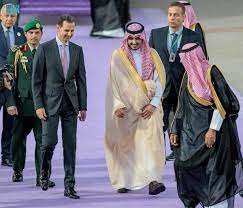Arab leaders, including Syrian President Bashar Assad, gathered in Saudi Arabia for an annual summit on May 17, marking a significant development as Assad’s attendance marked the first time in over a decade that he participated in such a gathering. The summit focused on addressing conflicts in Sudan and other regional issues, while also highlighting Saudi Crown Prince Mohammed bin Salman’s proactive approach to regional diplomacy.
The presence of Bashar Assad at the summit was noteworthy, as it signaled a potential shift in regional dynamics. For more than ten years, Assad had been isolated by the Arab world due to his role in the Syrian civil war, which began in 2011. However, his attendance at the summit suggested a willingness among Arab leaders to engage with him and explore possible avenues for resolving the conflict in Syria.
The summit’s central agenda revolved around discussions about Sudan and other ongoing conflicts in the region. Sudan, in particular, has experienced political instability and violence in recent years. Arab leaders aimed to address these issues collectively and seek ways to restore stability and peace in the country.
In addition to the specific focus on Sudan, the summit provided an opportunity for regional leaders to engage in broader discussions about regional security and cooperation. Crown Prince Mohammed bin Salman, known for his assertive approach, has been actively pursuing diplomatic initiatives in the region, demonstrating the same vigor he previously displayed in confronting Iran and its proxies.
Bin Salman’s engagement in regional diplomacy reflects Saudi Arabia’s desire to play a more prominent role in shaping the Middle East’s political landscape. The kingdom has traditionally been a key player in Arab affairs, and the crown prince’s assertiveness is aimed at safeguarding Saudi Arabia’s interests and countering Iranian influence in the region.
The presence of Arab leaders, including Assad, at the summit signaled a potential recalibration of regional alliances. While longstanding tensions and disagreements still exist, there appears to be a growing recognition among Arab states that collaboration and dialogue may be necessary to address common challenges effectively.
The Arab summit also served as a platform for Arab leaders to discuss potential avenues for resolving the Syrian civil war. While the conflict has caused immense suffering and displacement, it has also drawn in various regional and international actors, each with their own agendas. Finding a comprehensive solution to the Syrian crisis remains a complex task, but the summit provided an opportunity for Arab leaders to explore diplomatic initiatives and de-escalation efforts.
Overall, the annual summit in Saudi Arabia brought together Arab leaders, including Syrian President Bashar Assad, for the first time in over a decade. The focus on Sudan and other conflicts highlighted the region’s collective efforts to address pressing challenges. Crown Prince Mohammed bin Salman’s active engagement in regional diplomacy underlined Saudi Arabia’s commitment to shaping the Middle East’s political landscape. While significant hurdles remain, the summit provided a platform for dialogue and potential pathways towards resolving conflicts and promoting stability in the region.


